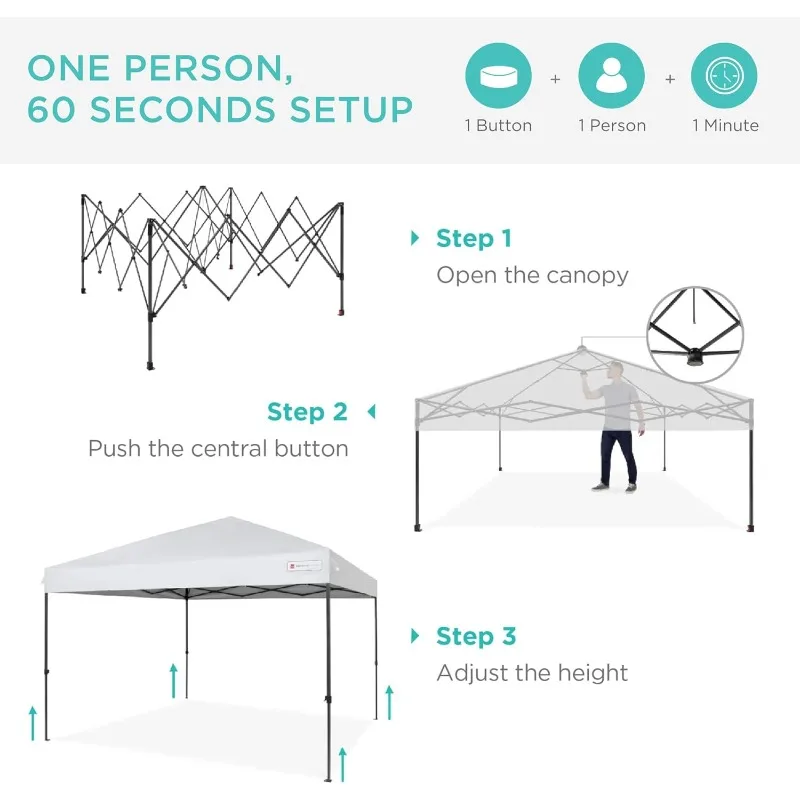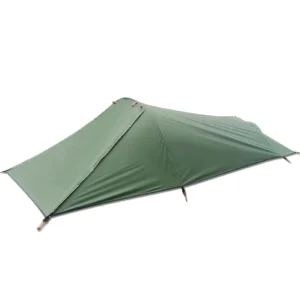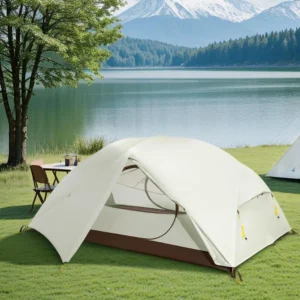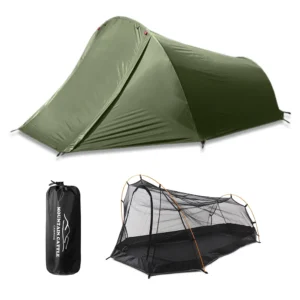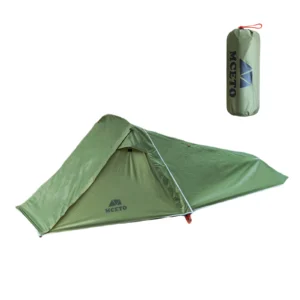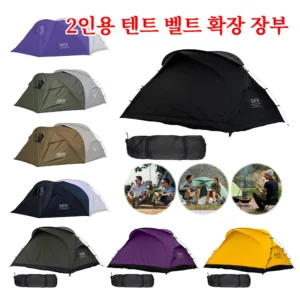1. Understanding Ultralight Tent Design: A Critical Choice for Backpackers
When every ounce matters on the trail, choosing between a freestanding or non-freestanding ultralight tent becomes one of the most consequential decisions a backpacker can make. Saving 1-2 pounds (0.45-0.9 kg) might seem insignificant in everyday life, but after miles of mountain terrain, that weight difference transforms from a minor detail into a major comfort factor.
Ultralight tent design fundamentally splits into two camps: freestanding tents that maintain their shape without stakes, and non-freestanding tents that require stakes, guylines, or trekking poles to create their structure. This distinction impacts everything from setup speed to terrain adaptability to overall trail experience.
Whether you’re a weekend warrior or a thru-hiker tackling major trails, understanding these different shelter options for two campers will directly influence your comfort, efficiency, and enjoyment outdoors. In this comprehensive guide, we’ll explore definitions, detailed comparisons, and a decision framework to help you select the perfect ultralight shelter for your specific adventures.
2. Defining the Designs: What Makes a Tent Freestanding or Non-Freestanding?
Freestanding Tents
Freestanding tents maintain their structure completely through a self-supporting pole system. Once assembled, these tents can technically stand without stakes—though you’d still want to secure them against wind. Modern ultralight freestanding designs typically use lightweight aluminum or carbon fiber poles arranged in hub-based or crossing configurations to create a free-standing structure.
The freestanding tent structure allows for exceptional stability through architectural principles that distribute tension throughout the pole system rather than relying on ground anchors for fundamental support. These designs evolved from traditional camping tents but have been progressively refined with specialized materials to minimize weight while maintaining structural integrity.
Non-Freestanding Tents
Non-freestanding tents (sometimes called semi-shelters) require external support—typically stakes, guylines, and often trekking poles—to create and maintain their shape. Without proper staking or pole support, they simply collapse. These designs achieve remarkable weight savings by eliminating most or all dedicated tent poles.
Many ultralight non-freestanding tents employ a ridgeline design where trekking poles support the highest points, while tension from multiple stake-out points creates the living space. This design philosophy prioritizes weight savings and simplicity over standalone stability.
Semi-Freestanding Hybrids
Semi-freestanding tents represent a middle ground, using some pole structure for partial stability but still requiring stakes for full setup. These designs often feature pole support at the head end with a staked-out foot end, creating a compromise that captures benefits of both approaches.
3. Comprehensive Comparison: Freestanding vs. Non-Freestanding at a Glance
| Feature | Freestanding Ultralight Tents | Non-Freestanding Ultralight Tents |
|---|---|---|
| Typical Weight | 2.5-3.5 lbs (1.1-1.6 kg) | 1.5-2.5 lbs (0.7-1.1 kg) |
| Packed Size | Moderate (6-7” × 18-20”) | Smaller (4-6” × 12-18”) |
| Setup Time | 3-5 minutes | 5-10 minutes |
| Setup Complexity | Simple, intuitive | Moderate, requires practice |
| Weather Stability | Good to excellent | Good to excellent (when properly pitched) |
| Rocky/Difficult Terrain | Excellent | Fair to challenging |
| Sandy/Soft Ground | Good | Fair (needs specialized stakes) |
| Interior Space | Maximized headroom | Often tapered/sloped walls |
| Ventilation | Generally better cross-ventilation | Design dependent, often more limited |
| Price Range | Generally higher | Often less expensive |
| Durability | Pole stress points | Fabric stress points |
| Required Accessories | None essential | Trekking poles or separate tent poles |
Browse our selection of ultralight freestanding tent options to see the latest designs incorporating these features.
4. The Weight Factor: Comparing Pack Weight and Bulk
Weight remains the most compelling reason many backpackers choose non-freestanding designs. The weight difference can be substantial—ultralight non-freestanding shelters often weigh under 2 pounds (0.9 kg) while comparable freestanding models typically start around 2.5-3 pounds (1.1-1.4 kg).
This weight advantage comes primarily from:
– Elimination of most or all dedicated poles
– Simpler structural design requiring less fabric
– Minimalist features and accessories
When considering “effective weight,” the picture becomes more nuanced for trekking pole users. If you already carry trekking poles, non-freestanding tents essentially “borrow” gear you’re already carrying, making the effective weight difference even more significant. However, if you don’t use trekking poles for hiking, you’ll need to account for their weight or purchase dedicated tent poles.
Beyond raw weight, packed size also favors non-freestanding designs. Without rigid pole structures, these tents typically compress to significantly smaller volumes—a benefit that extends beyond weight to pack organization. Understanding what makes a tent ultralight helps in recognizing these critical design tradeoffs.
5. Setup Process and Learning Curve: From Pitch to Camp
Freestanding Tent Setup
- Lay out the tent body flat
- Assemble pole structure outside or inside tent
- Insert poles into grommets/attachments
- Clip tent body to poles
- Stake out for stability (optional but recommended)
- Attach rainfly if separate
Experienced users can complete this process in 3-5 minutes, with the significant advantage that the tent can be picked up and repositioned without complete disassembly if the initial spot proves unsuitable.
Non-Freestanding Tent Setup
- Select appropriate site with suitable staking ground
- Lay out and stake tent corners according to specific pattern
- Extend trekking poles to precise height
- Insert poles into designated attachments
- Raise tent structure
- Adjust stake tension and pole height for proper pitch
- Add additional stake-out points for stability and ventilation
This process typically takes 5-8 minutes for experienced users but can require significant practice to master. Proper tensioning is critical and often requires adjustment after initial setup as materials settle.
Mastering two-person lightweight tent setup techniques will significantly improve your efficiency with either design, but the learning curve remains steeper for non-freestanding options.
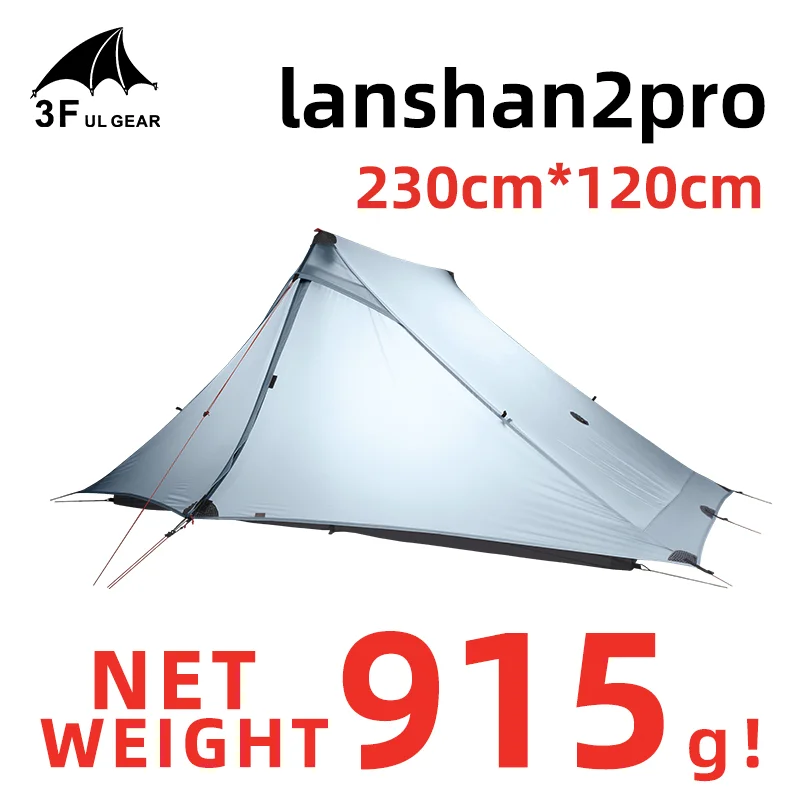
6. Terrain Adaptability: Where Each Design Excels
Terrain adaptability represents perhaps the most significant functional difference between these designs. Freestanding tents shine on challenging surfaces—rocky ground, established wooden platforms, sandy beaches, or frozen ground—where securing stakes is difficult or impossible.
A freestanding tent can be set up on a solid rock slab if necessary, with rocks placed on corners for wind security. In contrast, non-freestanding designs require appropriate ground for stake insertion or creative anchoring solutions.
Specific terrain challenges for non-freestanding tents include:
– Rocky terrain with minimal soil for stakes
– Sandy beaches or desert environments (requiring specialized stakes)
– Wooden platforms on established campsites
– Frozen ground in winter camping conditions
Experienced users of trekking pole backpacking tent designs develop adaptations for these challenges—using rocks as anchors, stuffing stakes into crevices, or employing specialized sand/snow stakes—but these solutions add complexity and sometimes compromise stability.
For varied terrain across a long hike or for those who frequently camp in challenging environments, freestanding designs offer significant versatility advantages, while non-freestanding options excel when you know you’ll have suitable staking ground.
7. Weather Resistance and Stability in Challenging Conditions
Both designs can offer excellent weather protection when properly pitched, but they achieve stability through different means:
Wind Performance
- Freestanding tents rely on rigid pole structures that flex under pressure and return to shape. They typically handle multidirectional winds better.
- Non-freestanding tents depend on precise tensioning and can actually be more aerodynamic in some designs, particularly low-profile pyramid shapes.
Properly guyed out, both designs can withstand significant wind—upwards of 30-40 mph (48-64 km/h) for quality models. However, freestanding tents generally maintain their interior space better under pressure, while non-freestanding designs may deform more under wind load, reducing livable space.
For optimal protection in severe conditions, mastering wind stability freestanding tent techniques becomes essential regardless of design. Additional guylines and strategic orientation to wind direction significantly improve performance for both tent types.
Rain resistance depends more on design specifics and materials than on the freestanding/non-freestanding distinction, though proper tensioning of non-freestanding designs is essential to prevent water pooling or splashback.
8. Interior Livability: Space, Comfort, and Organization
Despite similar floor dimensions, the usable living space differs significantly between these designs:
Freestanding tents typically feature:
– More vertical walls that maximize interior volume
– Better headroom throughout the tent
– More consistent height from end to end
– Less interior space consumed by sloping walls
Non-freestanding tents often have:
– More severely sloped walls that reduce usable space
– Higher center points but quickly diminishing height
– Greater variability in usable space depending on pitch quality
This difference is particularly noticeable when shared by two people. Non-freestanding tents often taper more dramatically from center height of 40 inches (101.6 cm) to edge height of 24 inches (61 cm), creating a more confined feeling despite similar floor dimensions.
Maximizing space comfort ultralight shelters becomes especially important with non-freestanding designs, where careful gear organization can significantly improve livability.
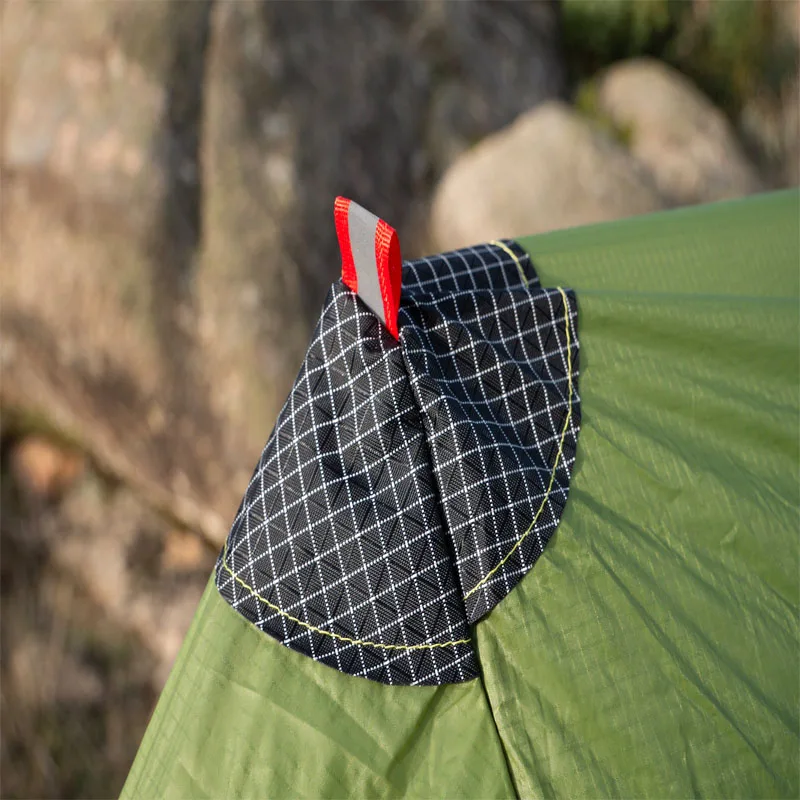
9. Condensation Management and Ventilation Strategies
Condensation management differs significantly between designs and is further complicated by the prevalence of single-wall construction in many ultralight non-freestanding tents:
- Freestanding tents typically employ double-wall construction with mesh inner tents that promote air circulation and separate campers from condensation on the fly.
- Non-freestanding tents more frequently use single-wall designs where condensation forms directly on the walls surrounding campers.
Ventilation features to look for include adjustable peak vents that can remain open during light rain, protected doorway options for air circulation in poor weather, and strategic mesh panels.
For the most challenging conditions, understanding the differences between single-wall vs double-wall ultralight tents helps in selecting appropriate designs and managing condensation effectively regardless of which structural style you prefer.
10. Durability and Longevity: What to Expect from Your Investment
Durability considerations differ significantly between designs:
Freestanding Tents
- Primary wear points concentrate at pole hubs and insertion points
- Pole failure is the most common critical failure
- Field repairs often more challenging without replacement parts
Non-Freestanding Tents
- Primary wear points are stake loops and trekking pole insertion points
- Fabric stress at tension points causes most failures
- Usually simpler to field repair with basic supplies
With proper care, quality ultralight tents of either design can last 500+ nights of use, though this requires diligent maintenance and appropriate use. The simpler construction of many non-freestanding tents can sometimes lead to better longevity, particularly for those comfortable with basic repairs.
For any ultralight shelter, understanding durability ultralight hiking tents principles helps maximize lifespan through proper care, storage, and maintenance practices.
11. Which Is Right for You? A Decision Framework
Consider prioritizing a freestanding tent if you:
– Frequently camp on challenging surfaces (rock, sand, platforms)
– Prefer simpler, more intuitive setup
– Often reposition your tent after initial setup
– Value maximized interior living space
– Are new to ultralight backpacking
– Share your tent with a partner who has less technical experience
Consider prioritizing a non-freestanding tent if you:
– Prioritize absolute minimum weight
– Already use trekking poles while hiking
– Typically camp on ground suitable for stakes
– Have experience tensioning and pitching technical shelters
– Primarily backpack solo or with equally experienced partners
– Frequently hike long distances where weight savings compound
For specific trip types:
– Weekend backpacking: Either design works well; convenience might favor freestanding
– Thru-hiking: Weight savings of non-freestanding becomes more valuable
– Winter camping: Design-dependent, but freestanding often provides more stability
– Desert environments: Freestanding offers significant advantages
For options that embrace the trekking pole supported design philosophy, explore our ultralight trekking pole tent collection.
12. Pitching Techniques: Mastering Your Tent Setup
Non-Freestanding Tent Mastery
Site selection becomes critical: Look for ground that will accept stakes well and has minimal slope.
Sequential tensioning technique: Rather than fully securing any one stake, create a balanced tension by partially securing all corners before final adjustments.
The stake-adjust-restake method: After initial setup, identify areas with improper tension, then adjust and restake for optimal pitch.
Alternative anchoring: Learn to use rocks, logs, or stuff sacks filled with material as anchors when traditional staking isn’t possible.
Freestanding Tent Optimization
Pole assembly sequence matters: Learn the optimal order for connecting pole segments to minimize stress.
Even when “freestanding,” always stake: Secure your tent appropriately even though it can stand alone.
Create symmetrical tension: Ensure balanced tension across attachment points to maximize stability and interior volume.
For both designs, site selection dramatically impacts comfort. Choose locations that offer natural wind protection, avoid low areas where water collects, and provide flat sleeping surfaces. Proper orientation to prevailing winds—typically with the narrowest profile facing into the wind—maximizes stability.
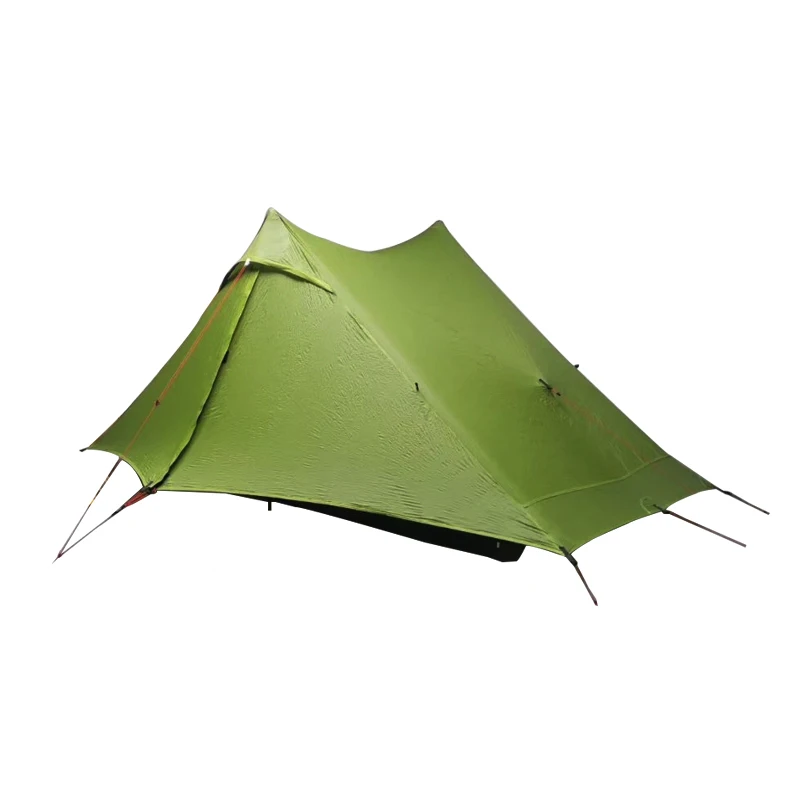
Making the right choice becomes easier when you know how to pick perfect ultralight backpacking tent for your specific needs and camping style.
13. Notable Ultralight Tent Models Worth Considering
While the ultralight tent market evolves constantly, certain design approaches have proven particularly successful:
Innovative Freestanding Designs
- Hub-based pole structures that maximize strength-to-weight ratios
- Semi-freestanding designs with pole support at one end and stakes at the other
- Y-shaped pole configurations that reduce weight while maintaining stability
Distinctive Non-Freestanding Approaches
- A-frame designs using trekking poles at both ends
- Mid (pyramid) styles with central pole support
- Tarp-tent hybrids that blend minimalism with bug protection
The market spans from budget-friendly options under $200 to premium ultralight shelters exceeding $500, with significant quality and feature differences across price points.
Lightweight Backpacking Tent, Ultralight Backpacking Tent, Ultralight Bivy Tent
Ultralight Single Person Camping Tent with Aluminum Poles for 3-Season Backpacking Waterproof DesignPrice range: $94.88 through $326.82 Select options This product has multiple variants. The options may be chosen on the product pageLightweight Backpacking Tent, Ultralight Backpacking Tent, Waterproof Backpacking Tent
$391.05 Select options This product has multiple variants. The options may be chosen on the product pageCompact Backpacking Tent, Lightweight Backpacking Tent, Waterproof Camping Tent
$335.52 Select options This product has multiple variants. The options may be chosen on the product pageHeavy Duty 4 Season Tent, Ultralight Freestanding Tent, Winter Camping Tent
$3,722.66 Select options This product has multiple variants. The options may be chosen on the product pageBackpacking Tent with Vestibule, Freestanding Backpacking Tent, Lightweight Backpacking Tent
Price range: $446.89 through $447.22 Select options This product has multiple variants. The options may be chosen on the product pageBackpacking Tent with Vestibule, Trekking Pole Backpacking Tent, Waterproof Camping Tent
Price range: $271.99 through $519.52 Select options This product has multiple variants. The options may be chosen on the product page
For those seeking options across different design philosophies, our lightweight backpacking tent collection offers diverse choices balancing weight, features, and livability.
14. Frequently Asked Questions: Expert Answers
Can non-freestanding tents be used without trekking poles?
Yes, most manufacturers offer compatible tent poles as accessories. These add some weight but allow flexibility when you don’t want to use trekking poles.
Are freestanding tents truly freestanding in practice?
While they can stand without stakes, proper use always involves staking for stability. The “freestanding” advantage is primarily in setup flexibility and the ability to move the pitched tent.
Which design typically packs smaller?
Non-freestanding tents almost always pack smaller due to the absence or minimization of rigid pole structures.
How do the designs compare in high winds?
Both can perform well when properly pitched. Freestanding designs resist deformation better, while some non-freestanding designs can be more aerodynamic when oriented correctly.
Are non-freestanding tents always lighter?
Generally yes, but there’s overlap. The lightest non-freestanding options are lighter than any freestanding design, but some heavier non-freestanding tents may weigh more than ultralight freestanding models.
For couples seeking shelter solutions, choosing ultimate compact shelter for two provides additional guidance on navigating these options as a pair.
15. Beyond the Tent: Complementary Gear Considerations
Your tent choice influences other gear decisions throughout your backpacking system:
Trekking Pole Considerations
If selecting a non-freestanding tent, pole compatibility becomes essential. Not all trekking poles work equally well with all tent designs, particularly regarding:
– Maximum height capabilities
– Locking mechanism reliability under tension
– Grip/handle compatibility with tent attachment points
Exploring compatible trekking poles tents ensures your entire shelter system works harmoniously.
Ground Protection
Regardless of tent style, consider groundsheet options:
– Manufacturer-specific footprints (convenient but heavier)
– Polycryo plastic sheets (ultralight but less durable)
– Tyvek sheets (balanced durability and weight)
Specialized Stakes
Different environments demand different anchoring solutions:
– Y-stakes for all-around use
– Nail-style stakes for hard ground
– Wider snow/sand stakes for loose surfaces
At Explore Elements, we believe the perfect tent balances weight savings with your comfort needs and camping style. Both freestanding and non-freestanding designs offer distinct advantages, and many experienced backpackers eventually own both for different adventure types. The best ultralight tent is ultimately the one that supports your specific outdoor goals while providing reliable shelter in your preferred environments.

